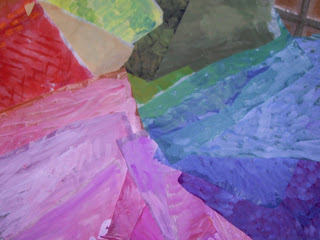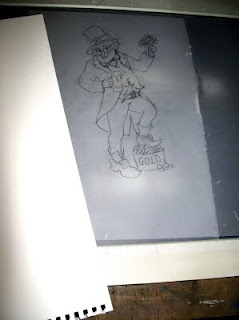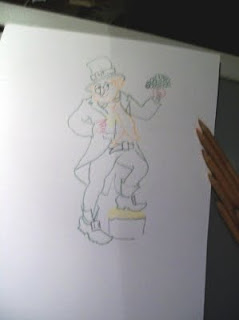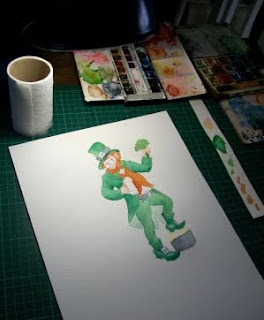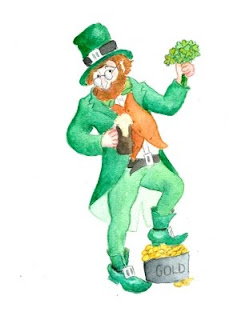
The slightly tricky bit about making a collage design like the one above is knowing how to position all your pieces correctly in relation to one another. Of course the problem doesn't arise if you are creating a purely 'decide-as-you-go-along' collage. But sometimes it is necessary to work out in advance exactly where each element of your design is to go, particularly when working with lettering.
The design above may look as if I just stuck on the letters wherever I fancied. But, although I wanted to give my card an informal, spontaneous look, with the letters 'bouncing' up and down on the 'line', in fact it was all carefully planned. You don't want to get to the last letter and find that it doesn't fit within the bounds of your page!
So here are my step-by-step instructions for making quite sure that everything stays in its allotted position within my design -
1.
- First, make a cardboard frame with a 'window' that reveals the space you have to work within - here it is 10.5" x 7.5" because the finished card will need to be 7" x 5".
- Then place a sheet of tracing paper over a drawing or print-out of the design - in this case, the word 'Daniel' using a rather fun font called 'Grumble' at its largest fontsize.
- Next place the 'frame' in position on top of the design and the tracing paper. (You will have 3 layers - underneath will be the design, on top of that the tracing paper, and on top of both, the cardboard frame).
 Once the three layers are in a position you are happy with, use a pencil to trace carefully round the 'design' and the inside of the frame.
Once the three layers are in a position you are happy with, use a pencil to trace carefully round the 'design' and the inside of the frame.
2.
- You will now have a tracing of the whole design and the parameters of the area available to work with.
- So next you can move on to cutting out your collage pieces. Choose the collage paper you want to use for the first letter - I used papers that I had previously painted with acrylics but you may want to use attractive pieces of giftwrap or even coloured pieces from magazine pages!
- Lay the tracing over the collage paper and carefully cut around the shape of the letter, making sure you cut through both the tracing and the collage paper. A craft-knife will probably do a better job than scissors as that way you can keep the tracing firmly in position.
(Sometimes, depending on the paper, it's easier to see what you are doing when you're cutting, if you work on the back (plain) side of the paper, but if you do this, be sure to turn your tracing paper over so that you don't end up with a 'backwards' letter!)

3.
You will now have your first collage letter cut out and ready to stick to your backing card. And it's here that the question is, how do you make sure that you stick it in precisely the right place?

My easy method is to -
- First, use the frame to mark out the boundaries of your working area on the backing card you will use for your collage.
- Then lay the tracing paper over the backing card, making sure that the outlines of the working area on both layers (the card and the tracing) are accurately lined up.
- Next very lightly indicate in pencil where the first letter will be placed, using the hole in your tracing paper as your guide.Make sure that your pencil lines will come underneath the coloured paper that you are going to stick on the back card so that they won't show.
- Stick down your first letter, using your pencilled guidelines to get the position right.
(If you are using tissue paper, your guidelines will need to be very light indeed! Or alternatively, you can mark out the position of the letter with glue on a cotton bud and stick down the letter while the tracing is still in position.)

4.
- With the first letter now stuck in its correct position, repeat the same procedure for each letter, using the tracing to mark out the relative positions of the letters each time. This way you can hardly go wrong!

With the addition of a more or less random sprinkling of stars (or flowers, perhaps, for a girls' card), your card is now ready to scan and have the 'Happy Birthday' added on the computer.

Through much trial and error, I've found this to be the easiest, most fail-safe way to make sure that all the elements of my design are in the correct position - particularly important if your design contains people or animals!
The bonus is that with a simple design like a 'name' card, you will be left with a tracing paper template, that you might like to use again for another project!
'Here's one I made earlier!'

You can, of course, use a different colour for your backing paper. Black gave a very vibrant effect and I considered using black backing card. But to save myself time and work, I decided to use white card for all my name cards and to use my photo-editing programme to make different coloured backgrounds.
Of course, it would probably have been much quicker and easier to have created the whole thing on the computer, using 'layers'! But, apart from the fact that I have yet to completely understand how to use 'layers', I do think there is an elusive 'something' about hand-made collage that is absent from completely computer-generated work - maybe I'm biased?
You can see my 'name' designs made into birthday cards, as well as a selection of birthday cards I've designed in different styles, in my
Zazzle store. Many have matching mugs and other gifts to go with them!
 Christmas doesn't seem all that long ago and yet the shops have already well and truly moved on to the next excuse to separate us from our cash. It's not just cards - there's everything you need to properly celebrate St Valentine's Day, from overpriced, over-packaged confectionery to naughty knickers!
Christmas doesn't seem all that long ago and yet the shops have already well and truly moved on to the next excuse to separate us from our cash. It's not just cards - there's everything you need to properly celebrate St Valentine's Day, from overpriced, over-packaged confectionery to naughty knickers!













